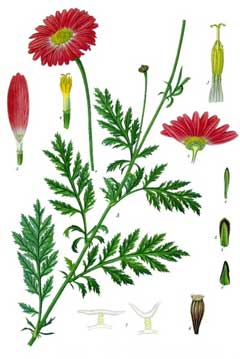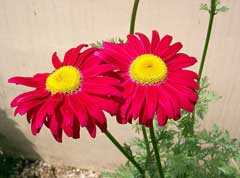 |
|
http://commons.wikimedia.org/wiki/File:Koeh-035.jpg |
 |
| http://commons.wikimedia.org/wiki/File:Tanacetum_coccineum2.jpg |
Translate this page:
Summary
Bloom Color: Pink, Red, White. Main Bloom Time: Early summer, Late spring. Form: Upright or erect.
Physical Characteristics

 Tanacetum coccineum is a PERENNIAL growing to 0.6 m (2ft) at a medium rate.
Tanacetum coccineum is a PERENNIAL growing to 0.6 m (2ft) at a medium rate.
See above for USDA hardiness. It is hardy to UK zone 5. It is in flower from July to August. The species is hermaphrodite (has both male and female organs) and is pollinated by Insects.
Suitable for: light (sandy), medium (loamy) and heavy (clay) soils. Suitable pH: mildly acid, neutral and basic (mildly alkaline) soils. It can grow in semi-shade (light woodland) or no shade. It prefers moist soil.
UK Hardiness Map
US Hardiness Map
Synonyms
Chrysanthemum coccineum. Willd. C. roseum. Pyrethrum roseum.
Plant Habitats
Meadow; Cultivated Beds;
Edible Uses
References More on Edible Uses
Medicinal Uses
Plants For A Future can not take any responsibility for any adverse effects from the use of plants. Always seek advice from a professional before using a plant medicinally.
None known
References More on Medicinal Uses
The Bookshop: Edible Plant Books
Our Latest books on Perennial Plants For Food Forests and Permaculture Gardens in paperback or digital formats.

Edible Tropical Plants
Food Forest Plants for Hotter Conditions: 250+ Plants For Tropical Food Forests & Permaculture Gardens.
More

Edible Temperate Plants
Plants for Your Food Forest: 500 Plants for Temperate Food Forests & Permaculture Gardens.
More

More Books
PFAF have eight books available in paperback and digital formats. Browse the shop for more information.
Shop Now
Other Uses
Insecticide
The dried flower heads are used as an insecticide[46, 61, 114, 169, 171], they are a source of the commercially available insecticide 'pyrethrum', which is non-toxic to mammals[238]. This species is less effective than T. cinerariifolium[238]. Only the yellow disk rays contain pyrethrins[169]. Once dried, the flowers or the powder retain their insecticidal properties almost indefinitely[238].
Special Uses
Food Forest
References More on Other Uses
Cultivation details
Landscape Uses:Border, Container, Foundation, Massing, Rock garden. Succeeds in most soils so long as they are not very heavy or wet[200]. Thrives in full sun but also succeeds in light dappled shade though it flowers less well in such a situation[200]. Another report says that it requires a sunny position in a well-drained alkaline or neutral soil[169]. Prefers a slightly acid sandy soil[187]. Tolerates a pH in the range 5.2 to 7. A very ornamental plant[1], there are many named forms selected for their ornamental value[187, 200]. Very suitable for naturalizing in a summer meadow. Special Features:
Attractive foliage, Fragrant foliage, Attracts butterflies, Suitable for cut flowers, Suitable for dried flowers.
References Carbon Farming Information and Carbon Sequestration Information
Temperature Converter
Type a value in the Celsius field to convert the value to Fahrenheit:
Fahrenheit:
The PFAF Bookshop
Plants For A Future have a number of books available in paperback and digital form. Book titles include Edible Plants, Edible Perennials, Edible Trees,Edible Shrubs, Woodland Gardening, and Temperate Food Forest Plants. Our new book is Food Forest Plants For Hotter Conditions (Tropical and Sub-Tropical).
Shop Now
Plant Propagation
Seed - sow spring in a greenhouse. Only just cover the seed and do not allow the pot to dry out. Prick out the seedlings into individual pots once they are large enough to handle and grow them on in the greenhouse for their first winter. Plant out in late spring or early summer. Division in spring. Larger divisions can be planted out direct into their permanent positions. We have found that it is best to pot up smaller divisions and grow them on in light shade in a greenhouse or cold frame until they are growing away well. Plant them out in the summer or the following spring.
Other Names
If available other names are mentioned here
Native Range
Coming Soon TEMPERATE ASIA: Iran (north), Turkey (northeast), Russian Federation-Ciscaucasia (Ciscaucasia), Armenia, Azerbaijan, Georgia
Weed Potential
Right plant wrong place. We are currently updating this section.
Please note that a plant may be invasive in one area but may not in your area so it's worth checking.
Conservation Status
IUCN Red List of Threatened Plants Status :

Growth: S = slow M = medium F = fast. Soil: L = light (sandy) M = medium H = heavy (clay). pH: A = acid N = neutral B = basic (alkaline). Shade: F = full shade S = semi-shade N = no shade. Moisture: D = dry M = Moist We = wet Wa = water.
Now available:
Food Forest Plants for Mediterranean Conditions
350+ Perennial Plants For Mediterranean and Drier Food Forests and Permaculture Gardens.
[Paperback and eBook]
This is the third in Plants For A Future's series of plant guides for food forests tailored to
specific climate zones. Following volumes on temperate and tropical ecosystems, this book focuses
on species suited to Mediterranean conditions—regions with hot, dry summers and cool, wet winters,
often facing the added challenge of climate change.
Read More
Expert comment
Author
(Willd.)Grierson.
Botanical References
200
Links / References
For a list of references used on this page please go here
Readers comment
| Add a comment |
|
If you have important information about this plant that may help other users please add a comment or link below. Only comments or links that are felt to be directly relevant to a plant will be included. If you think a comment/link or information contained on this page is inaccurate or misleading we would welcome your feedback at [email protected]. If you have questions about a plant please use the Forum on this website as we do not have the resources to answer questions ourselves.
* Please note: the comments by website users are not necessarily those held by PFAF and may give misleading or inaccurate information.
To leave a comment please Register or login here All comments need to be approved so will not appear immediately.
|
Subject : Tanacetum coccineum
|
|
|
|